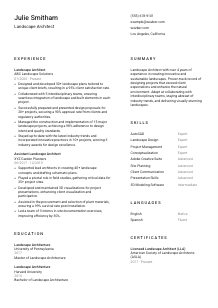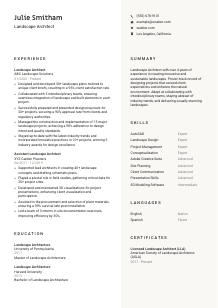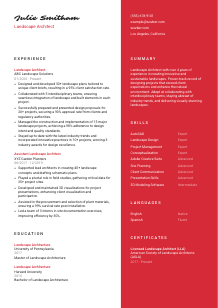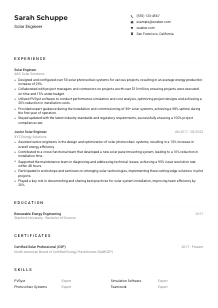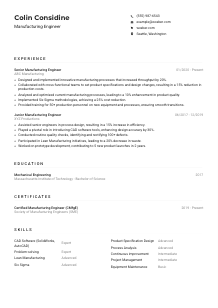Landscape Architect Resume Example
Sculpting green spaces, but your resume feels like it's lost among the shrubs? Delve into this Landscape Architect resume example, cultivated with Wozber free resume builder. Learn how to present your outdoor design finesse to mirror job criteria, so your career flourishes as beautifully as the gardens you create!

How to write a Landscape Architect resume?
Welcome, Landscape Architect hopeful. You already shape the physical world with artistry and vision; it's time to sculpt your resume with the same dedication. Here, we embark on a journey tailored to your profession, steering through each resume section with a focus on the Landscape Architect role.
Utilizing Wozber's free resume builder and its advanced features, like the ATS-friendly resume template and the powerful ATS resume scanner for optimal keywords optimization, you'll craft a narrative that lands your dream job. Let's unveil how to align your experience, skills, and achievements perfectly with your next big opportunity!
Personal Details
The foundation of an exceptional resume starts with the Personal Details section. This isn't merely about contact information; it's about setting a professional tone that harmonizes with your role as a Landscape Architect. We dissect this section to ensure pinpoint precision and alignment with the job's geographical and professional prerequisites.
1. A Name That Constructs an Image
Your name is the cornerstone of your professional brand. Highlight it with clear, professional typography, making it stand out as the creator of beautiful landscapes. This is the first step in asserting your identity in the Landscape Architectural realm.
2. The Title as a Reflection of Your Expertise
Directly beneath your name, proudly title yourself as a "Landscape Architect". This not only showcases your expertise but also harmonizes immediately with the job role you're targeting, functioning as a direct signal to the ATS and the hiring manager.
3. Crafting Your Contact Details
Your phone number and a professional email address (preferably firstname.lastname@email.com) are your conduits to potential employers. Verify their accuracy to ensure open channels of communication. Remember, every detail counts in building your professional image.
4. Grounding Your Locale
The job description calls for a candidate located in Los Angeles, California. Specifying your Los Angeles residency addresses a critical logistical requirement, ensuring you're seen as a viable and convenient candidate.
5. Your Professional Landscape
Including a link to an updated LinkedIn profile or personal portfolio website can provide a deeper insight into your professional journey. This allows employers to visualize the landscapes you've previously crafted, adding depth to your application.
Takeaway
Navigating the Personal Details section with strategic thoughtfulness sets a professional tone. It's your initial handshake with the potential employer, establishing a foundation of professionalism and suitability for the Landscape Architect role. Consider each detail a pebble in your career path, leading the way to your desired destination.





Experience
The Experience section is where you illustrate your professional journey, showcasing your impact on the landscape architecture world. It's about more than just what you did; it's about framing your contributions and projects in a way that resonates with the coveted Landscape Architect position.
- Designed and developed 30+ landscape plans tailored to unique client briefs, resulting in a 95% client satisfaction rate.
- Collaborated with 5 interdisciplinary teams, ensuring seamless integration of landscape and built elements in each project.
- Successfully prepared and presented design proposals for 20+ projects, securing a 90% approval rate from clients and regulatory authorities.
- Managed the construction and implementation of 15 major landscape projects, achieving a 98% adherence to design intent and quality standards.
- Stayed up‑to‑date with the latest industry trends and incorporated innovative practices in 10+ projects, winning 3 industry awards for design excellence.
- Supported lead architects in creating 40+ landscape concepts and drafting schematic plans.
- Played a pivotal role in field studies, gathering critical data for 25+ project sites.
- Developed and maintained 3D visualizations for project presentations, enhancing client visualization and participation.
- Assisted in the procurement and selection of plant materials, ensuring a 99% survival rate post‑installation.
- Led a team of 3 interns in site documentation exercises, improving efficiency by 30%.
1. Unearthing the Job's Core
Begin by taking a careful look at the job description. Extract crucial phrases like "collaborate with interdisciplinary teams" or "adherence to design intent and quality standards." Identifying these keywords is crucial for ATS optimization and ensures your resume speaks directly to the job's needs.
2. Structuring Your Landscape
Organize your professional experiences in reverse chronological order. For each role, list your title, the organization, and your period of employment. This structure gives clarity and shows a trajectory of growth and engagement in the field of landscape architecture.
3. Sowing Seeds of Success
Articulate your achievements and responsibilities, particularly those aligning with the job description. Did you design innovative outdoor spaces? Collaborate with builders and architects to bring your visions to life? Each bullet point should be a snapshot of your contribution and impact.
4. Measuring Your Gardening Success
Quantifying your achievements gives them weight. Whether it's the square footage of green spaces you've designed, the percentage of projects completed under budget, or the number of industry awards won, numeric values demonstrate the scale and impact of your work.
5. Pruning the Excess
Keep your focus sharp; ensure each point underlines your suitability for the Landscape Architect role. Extraneous information dilutes the potency of your resume. For instance, focus on your project leadership and design skills over unrelated tasks.
Takeaway
Think of the Experience section as your professional garden – every bullet point a carefully tended plant that showcases the variety and health of your career. By strategically organizing and tailoring this section, you invite the hiring manager to walk through your professional landscape, appreciating the breadth and depth of your contributions.
Education
In Landscape Architecture, your educational background is not just a testament to your knowledge—it's a reflection of your dedication and foundational understanding of the field. Crafting this section to echo the job's educational prerequisites establishes your eligibility and commitment.
1. Aligning With Educational Landscapes
Highlight your Bachelor's or Master's degree in Landscape Architecture to meet the job description's call for a "degree from an accredited institution." This alignment is critical, serving as a cornerstone of your qualifications.
2. The Structure of Academic Success
Maintain clarity by listing your degree, the field of study, the institution, and your graduation date. This straightforward structure helps hiring managers to quickly confirm your educational qualifications against their requirements.
3. Tailoring to the Terrain
Explicitly match your degrees and relevant coursework with the job's call for specialized knowledge in Landscape Architecture. This direct correlation will catch the eye of both the hiring manager and the ATS, reinforcing your suitability for the role.
4. Academic Projects: Highlighting Your Design Philosophy
Including significant projects or thesis work is especially beneficial if they directly relate to the landscapes you aspire to create. These academic endeavors offer insight into your design approach and problem-solving capability.
5. Other Educational Landmarks
Were you part of academic clubs, societies, or did you undertake additional courses relevant to landscape design and planning? Highlight these to show a rounded educational background and a proactive approach to your professional development.
Takeaway
Your Education section should serve as a blueprint, illustrating the strong foundations you've built in your journey to becoming a Landscape Architect. With each detail carefully placed, you affirm your readiness to traverse the professional landscapes ahead.
Certificates
Certifications can enrich your resume by showcasing your continuous learning and commitment to staying at the forefront of landscape architecture. They add another layer of credibility and specialization to your professional profile.
1. Gathering the Right Tools
Given the job description's lack of explicit certificate requirements, prioritize certifications that underscore your design mastery and technical skills, such as the "Licensed Landscape Architect (LLA)". Such credentials directly complement the skills and qualifications sought by employers in this field.
2. Strategically Displaying Your Credentials
Listing certifications that resonate closely with landscape architecture and the job description illuminates your dedication to the profession and deepens your expertise. It's about showing you're not just keeping pace but leading the charge in industry standards and innovations.
3. Marking the Time
Include acquisition or validity dates for your certificates, especially if they are particularly relevant or recent. This indicates to potential employers that your knowledge and skills are up-to-date, an essential factor in a fast-evolving field.
4. Cultivating Continuous Growth
The landscape architecture field is dynamic, with evolving trends and technologies. Demonstrate your commitment to professional development by regularly updating your certifications and seeking out opportunities to learn and apply new techniques and tools.
Takeaway
Certificates are milestones along your professional path, markers of continuous learning and commitment. They underscore your expertise and dedication, enriching your resume and setting you apart in the competitive landscape of landscape architecture.
Skills
The Skills section is a showcase of your professional toolbox. As a Landscape Architect, you possess a blend of creative design and technical proficiency. Let's ensure this section of your resume is pruned and cultivated to display the most precious skills that will catch an employer's eye.
1. Deciphering the Landscape
Start by identifying both the explicit and implicit skills required for the job. Skills like "Proficiency in AutoCAD, Adobe Creative Suite, and 3D modeling software" and "Strong design and conceptualization skills" are clearly defined and should be mirrored in your resume for ATS optimization.
2. Crafting Your Professional Garden
Only include skills that align with your profession and the job description. Prioritize technical skills like AutoCAD proficiency, alongside soft skills such as project management and collaborative teamwork. This demonstrates a well-rounded skill set paramount to the success of a Landscape Architect.
3. An Organized Arrangement
Keep your skills section tidy and approachable. Group similar skills together and arrange them in a way that mirrors the importance placed on them in the job description. This prioritization makes it easier for hiring managers (and ATS) to spot the competencies crucial for the role.
Takeaway
Skillfully curating your skills section plants seeds of interest in the minds of potential employers. It's a testament to your preparedness and compatibility with the landscape architecture role. Remember, each skill you list is a leaf on your career tree, contributing to the overall impression of your professional landscape.
Languages
In the diverse field of landscape architecture, the ability to communicate in multiple languages can be a distinct advantage. This section allows you to illustrate linguistic versatility and cultural sensitivity, reflecting your capability to work in varied environments and with diverse clientele.
1. Interpreting Language Needs
The job description specifies, "Ability to perform job duties in English is essential." Place English prominently in your languages section, denoting it as either 'Native' or 'Fluent', to meet this key requirement directly.
2. Cultivating Linguistic Variety
If you speak additional languages, list them to showcase your versatility. This can be particularly appealing in landscape architecture, where projects may span different regions or require interaction with diverse client bases.
3. Assessing Your Fluency
Be honest and clear about your language proficiency levels. Whether 'Native', 'Fluent', 'Intermediate', or 'Basic', an accurate representation ensures you can comfortably meet the communication demands of your role as a Landscape Architect.
4. Understanding the Role's Geographic Scope
Consider the job's geographical context and client demographics. If the role involves working in international markets or multicultural urban centers, highlighting your multi-language proficiency could significantly enhance your resume's appeal.
Takeaway
Your linguistic skills are an extension of your professional toolkit. They're not just about communication; they're about connection—connecting ideas, spaces, and people. Highlight your languages as bridges, integral to creating inclusive and engaging landscapes.
Summary
Your Professional Summary is the garden gate through which a potential employer enters your landscape. It's where you succinctly combine your passion, skills, and achievements. Craft this opener to draw employers into your professional world, keen to see the rest of your landscape.
1. Capturing the Essence of Your Role
Initiate your summary with a bold assertion of your profession - "Landscape Architect" - and the number of years of experience you bring. This sets the stage, preparing the reader for the professional journey they're about to witness.
2. Highlighting Masterful Creations
Mention your key skills and notable accomplishments next. Touch upon duties and achievements that align with the job description, such as your success in developing project plans and collaborating with teams, therefore underscoring your direct relevance to the position on offer.
3. Cultivating Interest
Keep the prose vibrant yet concise. Your Summary is the teaser, the intriguing cover of your professional book, inviting the hiring manager to dive deeper into the story of your career.
Takeaway
Compellingly crafting your Professional Summary is akin to laying a well-designed pathway into your resume. It beckons the hiring manager to step further, explore your skills, experiences, and the landscapes you've transformed. Let it mirror your capability and readiness to flourish in the new role, making it impossible for them to bypass your application.
Embarking on Your Landscape Architect Journey
Congratulations, you've journeyed through the nuances of crafting an ATS-compliant resume tailored for the landscape architecture profession. With Wozber's free resume builder at your fingertips, including ATS-friendly resume templates and an ATS resume scanner for optimal keyword use, you're well-equipped to design a resume that not only matches job requirements but also showcases your professional expertise and passion. Now, take this inspiration, wield the tools Wozber provides, and carve out your own path in the landscape architecture world. Your next big project awaits!

- Bachelor's or Master's degree in Landscape Architecture from an accredited institution.
- Minimum of 3 years of professional experience in landscape architecture or a related field.
- Proficiency in AutoCAD, Adobe Creative Suite, and 3D modeling software.
- Strong design and conceptualization skills with a portfolio that demonstrates a range of project types and scales.
- Professional licensure as a Landscape Architect is preferred.
- Ability to perform job duties in English is essential.
- Must be located in Los Angeles, California.
- Design and develop landscape plans in response to specific client briefs and site conditions.
- Collaborate with interdisciplinary teams to ensure the integration of landscape and built elements.
- Prepare and present design proposals to clients, stakeholders, and regulatory authorities.
- Oversee the construction and implementation of landscape projects, ensuring adherence to design intent and quality standards.
- Stay updated with the latest industry trends, best practices, and innovations, and incorporate them into projects as appropriate.





